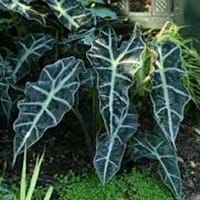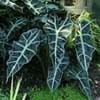Life Span
Annual
Perennial
Type
Tender Perennial
Fruit
Origin
Hybrid origin
China
Types
Alocasia macrorhizzos, Alocasia odora
Actinidia deliciosa chlorocarpa, Actinidia deliciosa deliciosa
Number of Varieties
Not Available
Habitat
Pastures, Wet forest
Mountain forests
USDA Hardiness Zone
10-12
6-9
Sunset Zone
H1, H2, 22, 23, 24
4, 5, 6, 7, 8, 9, 12, 14, 15, 16, 17, 18, 19, 20, 21, 22, 23, 24
Habit
Clump-Forming
Vining/Climbing
Minimum Width
Not Available
Flower Color
White
Light Yellow, Ivory
Flower Color Modifier
Not Available
Bicolor
Fruit Color
Red
Tan, Brown
Leaf Color in Spring
Lime Green, Dark Green, Bronze
Green, Light Green
Leaf Color in Summer
Lime Green, Dark Green, Bronze
Green
Leaf Color in Fall
Green, Lime Green, Dark Green, Bronze
Light Green, Yellow green
Leaf Color in Winter
Lime Green, Dark Green, Bronze
Light Green
Leaf Shape
V-Shaped
Heart-shaped
Plant Season
Spring, Summer, Fall, Winter
Spring, Summer, Fall
Sunlight
Partial shade, Full Shade
Full Sun, Partial Sun
Type of Soil
Loam
Clay, Loam
The pH of Soil
Acidic, Neutral
Acidic, Neutral
Soil Drainage
Well drained
Average
Bloom Time
Indeterminate
Late Spring, Early Summer
Tolerances
Drought
Drought
Where to Plant?
Container, Ground
Ground
How to Plant?
creeping rhizomes, Vegetative Reproduction
Layering, Softwood cuttings
Plant Maintenance
Medium
Medium
Watering Requirements
Needs a lot of water initially
Water daily during growing season
In Summer
Lots of watering
Lots of watering
In Spring
Moderate
Moderate
In Winter
Average Water
Average Water
Soil pH
Acidic, Neutral
Acidic, Neutral
Soil Type
Loam
Clay, Loam
Soil Drainage Capacity
Well drained
Average
Sun Exposure
Partial shade, Full Shade
Full Sun, Partial Sun
Pruning
No pruning needed, Remove damaged leaves, Remove dead branches, Remove dead leaves
Prune for shortening long shoots, Prune in early summer, Prune in late winter
Fertilizers
since leafy plants, use higher nitrogen content fertilizer, slow-release fertilizers
Self-fertile
Pests and Diseases
Alternaria Leaf Spot, Leaf rust, Leaf spot, Snails
Armillaria root rot, Armored scales, Bleeding canker, Botrytis Blight, Crown gall, Nematodes, Phytophthora Root Rot, Red blotch
Plant Tolerance
Full Sun, Humidity, Soil Compaction
Drought
Flowers
Insignificant
Showy
Flower Petal Number
Single
Single
Foliage Texture
Bold
Medium
Foliage Sheen
Glossy
Matte
Attracts
Butterflies, pollinators, Snakes
Not Available
Allergy
conjunctivitis, Itchy eyes, Sore Throat, Vomiting
Inflammation, Mouth itching, Throat itching
Aesthetic Uses
Beautification, Cottage Garden, Showy Purposes
Not Used For Aesthetic Purpose
Beauty Benefits
Glowing Skin, Hair Conditioner
Beautiful Skin, Protects from sun damage
Edible Uses
Sometimes
Yes
Environmental Uses
Absorbs huge amounts of CO2, soil stabilisation, Very little waste
Air purification
Medicinal Uses
Aging, Digestion problems, Rheumatism
constipation, Heart problems, Low Blood Pressure
Part of Plant Used
Leaves, Rhizomes
Fruits
Other Uses
Application in Handicrafts, Florist trade and landscaping, Showy Purposes
Used As Food, Used for its medicinal properties
Used As Indoor Plant
No
No
Used As Outdoor Plant
Yes
Yes
Garden Design
Container, Feature Plant, Houseplant, Mixed Border, Tropical
Edible, Fruit / Fruit Tree, Rock Garden / Wall, Vine
Botanical Name
ALOCASIA x amazonica
ACTINIDIA deliciosa
Common Name
African Mask, Amazon Taro, Elephant Ear
Chinese Gooseberry, Fuzzy Kiwi, Kiwi
In Hindi
Alocasia
कीवी फल
In German
Alocasia
Kiwi, Chinesischer Strahlengriffel
In French
Alocasia
Kiwi, Groseille de Chine, Yang Tao, Souris végétale
In Spanish
Alocasia
kiwi, kivi, actinidia
In Greek
Alocasia
Ακτινίδια
In Portuguese
Alocasia
Quiuí
In Polish
Alocasia
Owoc kiwi
In Latin
Alocasia
Kiwi fructum
Phylum
Tracheophyta
Magnoliophyta
Class
Liliopsida
Magnoliopsida
Family
Araceae
Actinidiaceae
Clade
Angiosperms, Monocots
Angiosperms, Asterids, Eudicots
Tribe
Colocasiodeae
Not Available
Subfamily
Aroideae
Not Available
Number of Species
Not Available
Season and Care of Kris Plant and Kiwifruit
Season and care of Kris Plant and Kiwifruit is important to know. While considering everything about Kris Plant and Kiwifruit Care, growing season is an essential factor. Kris Plant season is Spring, Summer, Fall and Winter and Kiwifruit season is Spring, Summer, Fall and Winter. The type of soil for Kris Plant is Loam and for Kiwifruit is Clay, Loam while the PH of soil for Kris Plant is Acidic, Neutral and for Kiwifruit is Acidic, Neutral.
Kris Plant and Kiwifruit Physical Information
Kris Plant and Kiwifruit physical information is very important for comparison. Kris Plant height is 60.00 cm and width 60.00 cm whereas Kiwifruit height is 610.00 cm and width Not Available. The color specification of Kris Plant and Kiwifruit are as follows:
Kris Plant flower color: White
Kris Plant leaf color: Lime Green, Dark Green and Bronze
Kiwifruit flower color: Light Yellow and Ivory
- Kiwifruit leaf color: Green and Light Green
Care of Kris Plant and Kiwifruit
Care of Kris Plant and Kiwifruit include pruning, fertilizers, watering etc. Kris Plant pruning is done No pruning needed, Remove damaged leaves, Remove dead branches and Remove dead leaves and Kiwifruit pruning is done Prune for shortening long shoots, Prune in early summer and Prune in late winter. In summer Kris Plant needs Lots of watering and in winter, it needs Average Water. Whereas, in summer Kiwifruit needs Lots of watering and in winter, it needs Average Water.





